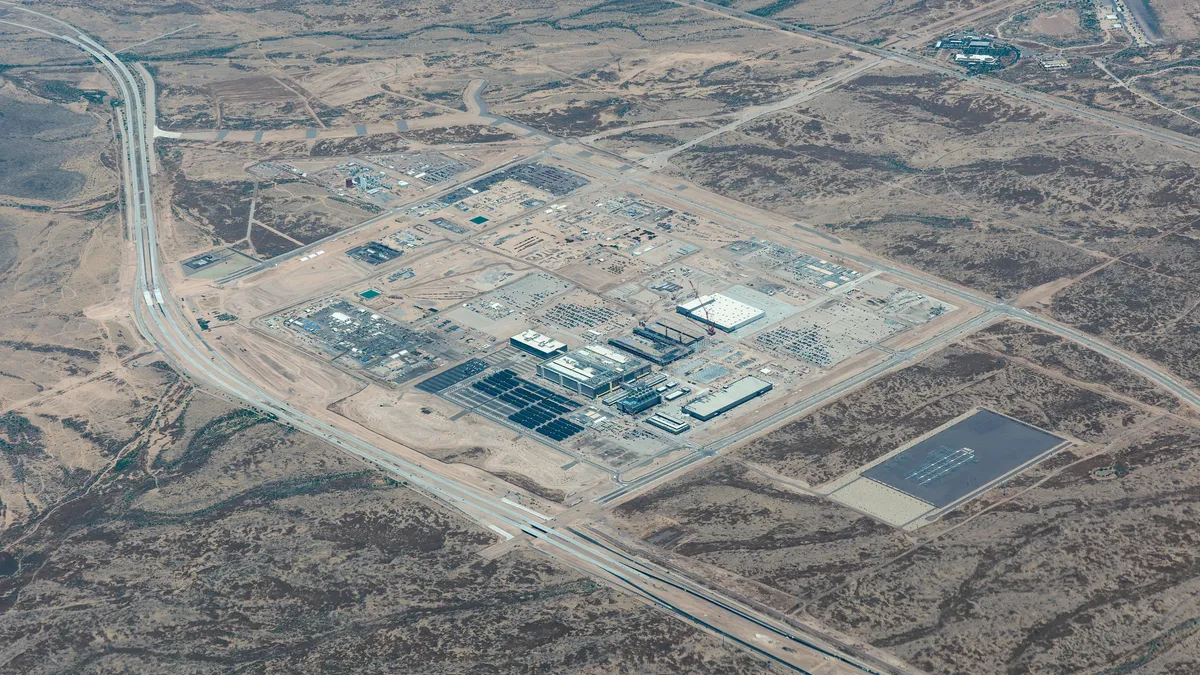In 2020, chip giant Taiwan Semiconductor Manufacturing Co. found the perfect site for its next generation $40 billion semiconductor manufacturing facility in the middle of Arizona’s Silicon Desert.
But three years later, the Taiwanese chipmaker is struggling to find workers to go with it.
Turns out, TSMC isn’t alone.
As billions in both public and private money flow into onshoring construction, labor shortages threaten to derail both the manufacturing boom and other construction activity in those hubs, according to industry sources.
Certain states — Arizona, Ohio, New York and Texas, to name a few — are rapidly becoming centers of manufacturing in the U.S. That centralization is putting great strain on the construction workforces in those communities, said Anirban Basu, chief economist at Associated Builders and Contractors.
[See Construction Dive’s tracker of the largest manufacturing projects in the country.]
“These projects are enormous, which means there is an outsized demand for subcontractors and workers,” Basu told Construction Dive. “Just trying to amass that much talent at one time in one place is very expensive.”

That’s because many of the skills needed to build an EV battery plant, for example, overlap with some of the same trades in demand to build other projects in the manufacturing space, like semiconductor facilities, said Brian Turmail, vice president of public affairs and strategic initiatives at Associated General Contractors of America. In other words, megaprojects in these areas are competing for the same labor, which is already scarce.
“Many of our members with auto manufacturing and semiconductor construction are struggling to find enough workers to meet very aggressive timelines,” said Turmail. “There’s enormous pressure to get these plants built.”
Special considerations
Multibillion-dollar manufacturing projects require special construction techniques including sophisticated electrical work and the need for “hyper clean spaces'' that differ from typical construction projects, said Turmail. These facilities must be protected by changes in air pressure to keep particulates out of rooms, which adds another layer of complexity for contractors.
Many of these structures must also be resistant to vibration and other environmental factors, said Basu.
Some projects, particularly for General Motors, Stellantis and Ford, the three largest car manufacturers in North America, carry additional union worker requirements as well, said Turmail. That further limits the pool of workers available.
For instance, Ford announced in February a $3.5 billion investment to build an EV battery plant in Marshall, Michigan, as part of an overall $50 billion effort to grow its EV business by 2026. General Motors in January announced a near $1 billion investment in four manufacturing sites.
Major plants like that don’t get built easily. For example, Intel’s $20 billion semiconductor manufacturing site in Licking County, Ohio, will need about 7,000 construction workers, according to the Associated Press.
That demand for construction workers across the country has demonstrated how strained the skilled construction workforce is, Basu said.
“And I emphasize the word skilled because this is not an ordinary form of construction, this is precision construction. You really need a very skilled workforce, and we just don’t have enough of those people.”
For their part, subcontractors may also end up working on these projects for years, which means they must have the financial wherewithal to complete the work, he added.
“Because there is so much at stake, [such as the] global market share in computer chips, for instance, the potential for legal liability is outsized,” said Basu. “Contractors have to deliver to specifications. Failure to do so can have extraordinary negative consequences.”
Positions remain unfilled
Manufacturing construction has been on a tear since the CHIPS Act passed in August 2022, yet labor shortages could affect that blistering pace.
Top manufacturing projects to break ground
| Name of plant | Location | Value |
|---|---|---|
| Samsung chip plant | Taylor, Texas | $25 billion |
| Intel semiconductor plant | Licking County, Ohio | $20 billion |
| Texas Instruments semiconductor wafer fab | Lehi, Utah | $11 billion |
| LG Energy Solutions battery complex | Queen Creek, Arizona | $5.5 billion |
| Hyundai EV plant | Ellabell, Georgia | $5.5 billion |
TSMC’s case provides an illustration of exactly those kinds of impacts.
Mark Liu, TSMC chairman, said in July during the company’s second quarter earnings call that there “is an insufficient amount of skilled workers with those specialized expertise required for equipment installation in a semiconductor-grade facility.”
For this reason, the semiconductor giant sent technicians from Taiwan to Arizona in order to train local workers. Still, the semiconductor company ultimately pushed back the opening of its Arizona chip factory until 2025 due to those skilled labor shortages.
That lack of specialized labor forms part of a greater trend of unfilled jobs in the U.S. construction industry, which had 374,000 open positions as of June. To fill the gap, Turmail said AGC members are reengineering plants in a way to work around the shortfall.

“[Labor shortages] are certainly changing the way the plants are built,” said Turmail. “To some extent, it may have an impact on cost and it may have an impact on scheduling, but I think that’s still playing out.”
AGC members have also been writing in longer timelines in their bids and raising their prices due to workforce shortages, Turmail said.
Short-term fixes
Owners of these multibillion-dollar starts are providing higher compensation in order to attract workers, said Ken Simonson, AGC chief economist.
But that is further aggravating labor shortages for other builders who may not be able to compete with those salaries, Dorsey Hager, executive secretary-treasurer of the Columbus/Central Ohio Building & Construction Trades Council, told Construction Dive.
For this reason, smaller contractors are offering amenities in addition to compensation in order to attract and retain workers. That includes everything from hot meals and heated bathrooms on jobsites to paid volunteer and education opportunities that may even extend to workers’ families.
Calls for immigration reform
Despite these immediate adjustments, both Turmail and Basu advocated for some form of temporary worker visa program to alleviate workforce shortages.
“Because we have this short term exigency, we really could use more global talent to help us bring these manufacturing plants online not just for semiconductors, but for batteries, alternative energy and electric vehicle projects,” said Basu. “[The U.S.] needs that skill, whether it’s from Taiwan, South Korea, Germany, France, wherever it happens to be, we could use it.”
That move would help fill the hundreds of thousands of vacant construction positions in the U.S., said New York Building Congress CEO Carlo Scissura. Turmail added, however, that immigration reform is currently not top of mind among legislators.
“We’re not, frankly, optimistic that the political climate is there for getting responsible immigration reform enacted,” said Turmail. “It’s too easy for parties on either side of the aisle to demagogue this issue without actually doing anything.”





















